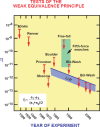The Confrontation between General Relativity and Experiment
- PMID: 28179873
- PMCID: PMC5256066
- DOI: 10.12942/lrr-2006-3
The Confrontation between General Relativity and Experiment
Abstract
The status of experimental tests of general relativity and of theoretical frameworks for analyzing them is reviewed. Einstein's equivalence principle (EEP) is well supported by experiments such as the Eötvös experiment, tests of special relativity, and the gravitational redshift experiment. Ongoing tests of EEP and of the inverse square law are searching for new interactions arising from unification or quantum gravity. Tests of general relativity at the post-Newtonian level have reached high precision, including the light deflection, the Shapiro time delay, the perihelion advance of Mercury, and the Nordtvedt effect in lunar motion. Gravitational wave damping has been detected in an amount that agrees with general relativity to better than half a percent using the Hulse-Taylor binary pulsar, and other binary pulsar systems have yielded other tests, especially of strong-field effects. When direct observation of gravitational radiation from astrophysical sources begins, new tests of general relativity will be possible.
Figures








References
-
- Adelberger EG. New tests of Einstein’s equivalence principle and Newton’s inverse-square law. Class. Quantum Grav. 2001;18:2397–2405. doi: 10.1088/0264-9381/18/13/302. - DOI
-
- Adelberger EG, Heckel BR, Nelson AE. Tests of the gravitational inverse-square law. Annu. Rev. Nucl. Sci. 2003;53:77–121. doi: 10.1146/annurev.nucl.53.041002.110503. - DOI
-
- Adelberger EG, Heckel BR, Stubbs CW, Rogers WF. Searches for new macroscopic forces. Annu. Rev. Nucl. Sci. 1991;41:269–320. doi: 10.1146/annurev.ns.41.120191.001413. - DOI
-
- Alväger T, Farley FJM, Kjellman J, Wallin I. Test of the second postulate of special relativity in the GeV region. Phys. Lett. 1977;12:260–262. doi: 10.1016/0031-9163(64)91095-9. - DOI
Publication types
LinkOut - more resources
Full Text Sources
